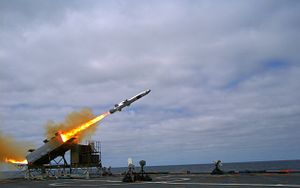The United States Navy wants to equip its burgeoning fleet of Littoral Combat Ships (LCS) with a new over-the-horizon missile by the end of 2016, the Navy’s surface warfare director, Rear Admiral Peter Fanta, told USNI News in a recent interview.
According to Fanta, equipping the LCSs with a new missile is “an absolute requirement” for the U.S. Navy. By the end of 2016 the admiral wants to have a new missile on the ships at least as a demonstration.
The U.S. Navy has rebranded the LCS as a frigate due to recent advances in effective counter-swarm defenses and is looking to increase the ships’ firepower. Naval engineers are currently studying what missile system would fit best on the LCS.
“It takes a little while for the guys with the slide rules to figure out… what the deck strength needs to be and what angle the launcher needs to sit at. That’s my biggest hold right now is guys doing math,” Fanta said.
As I reported earlier, the U.S. Navy still lacks an adequate long-range, anti-surface weapon to implement a re-organization of the surface fleet based on the “distributed lethality” idea (see: “The US Navy’s New Surface Warfare Strategy: ‘Distributed Lethality”).
Fanta emphasized that the U.S. Navy has not made a procurement decision yet:
I’m looking at a number of missiles – not just the Norwegian missile, I’m also looking at Harpoon and several other missiles. What bolts on, and what can I put on a console that has feeds from the combat system? … I’m trying to do that, again, if I can get enough engineering done to allow me to do this, I’m trying to do that this year.
The Norway-based Kongsberg Gruppen arms supplier and the U.S. missile manufacturer Raytheon have joined forces to try to convince the navy to acquire the fifth-generation over-the-horizon Kongsberg Naval Strike Missile (NSM) for the LCS.
Boeing Defense, Space & Security (BDS) also announced in April 2015 that it will offer an updated version of the Harpoon RGM-84 Block II anti-ship missile (ASM), called Harpoon Next Generation to the U.S. Navy.
In December 2015, Defense Secretary Ashton Carter ordered the U.S. Navy to reduce the number of LCS to be built from 52 to 40, which has met with resistance among some U.S. lawmakers.
As I reported previously, the 3,000-plus tons LCS is specifically tailored for shallow coastal waters and can customize around 40 percent of its volume to adapt to different mission sets (minesweeping, anti-submarine warfare, surface combat, etc.). It has been a controversial naval acquisition due to cost inflation and numerous design and construction issues.

































